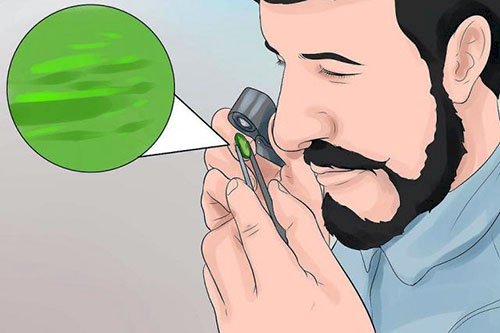How to Evaluate a Polished Emerald
See how to analyze a good quality cut emerald.

Emeralds are one of the most coveted gemstones for over 4,000 years. Countless historians have associated this gem with Queen Cleopatra, the last of the lineage of the Egyptian pharaohs. Cleopatra was so obsessed with emeralds that she often used them to adorn her dresses, jewelry and crowns. These stones are almost 20 times rarer than diamonds and have a very high value. [2] Although you probably don't want an emerald to put on a crown, you may be on the market looking to buy or sell a good quality gem. It is important to know the elements that contribute to the enhancement of an emerald, before buying or selling it.
Assessing clarity, cut and size

Look for inclusions
This term refers to any materials (such as air bubbles or small crystals) that have become trapped within the stone during its formation. Almost 99% of emeralds have inclusions visible to the naked eye or with the help of a small magnifying glass used by jewelers.
A large presence of inclusions classifies an emerald as a Type 3 gem, meaning that they can be seen with the naked eye or are always present.
An emerald with an excessive amount of inclusions that diminishes its transparency or clarity will be worth less than another, that has a smaller amount.
Watch out for inclusions that reach the surface of the stone, which can cause cracks.

Examine the cut of the emerald
Emeralds can be difficult to cut because the prevalence of inclusions makes them vulnerable to cracking during the cutting process. Emeralds are often cut into a rectangular shape (known as a "step cut" or "emerald cut") that helps maintain the consistency of your color.
Cutting an emerald should help protect it from possible damage from wear and tear.
A quality cut enhances the hue, tone and saturation of the emerald. It will make it shiny and attractive in color, while an improper cut can result in a good color, but with an opaque characteristic.

Emeralds come in different sizes
Like most gemstones, emeralds can exist in a wide variety of sizes, from small gems with 0.02 to 0.5 carats (1 to 5 mm) to 1 to 5 carats (7 to 12 mm) stones for rings or necklaces.

Size does not always represent the value
It is true that larger stones are more valuable than smaller ones. However, quality is as important as size, and large emeralds tend to have larger or more visible inclusions that can affect their clarity. A smaller, higher-quality stone is likely to be worth more than a larger, lower-quality stone. In addition, the color of a gem can significantly impact its value.

The importance of color
Emeralds come in many different shades. Thus, color represents one of the most important factors in determining its value. The variance in the color of emeralds occurs due to the different amounts of chromium, vanadium and iron in the environment where the stones were formed. It can be subdivided into hue, hue and saturation categories.

Identify the emerald hue
The hue is probably what you think of when you hear the word "color". The hue of an emerald refers to the specific type of green it has.
The emerald hues range from blue-green to yellow-green.
For example, emeralds obtained in Zambia are characterized by their deep bluish greens, while their mined counterparts in Brazil and Colombia have a purer and more intense green hue.

Notice the color tone of an emerald
The tone refers to the color shade of a stone. In the case of emeralds, it is possible to find shades of green very light and others very dark. The association between tone and value is difficult to establish. Darker emeralds are often considered more valuable, but if a stone gets too dark, it loses its value.
- Medium to medium-dark tones are the most valuable emeralds on the market.
- Emeralds with shades of pure green or bluish green are the most coveted, partly because they are associated with a Colombian mine with a high reputation, called Muzo.
- Be aware that stones that are very yellow or blue may not be considered emeralds and are therefore much less valuable.

Assess the saturation of an emerald
Saturation is associated with the transparency of an emerald. Gems with a high saturation (meaning they are very transparent) are more valuable than those with lower saturation levels.
This characteristic can be associated with both inclusion and tone; gems with many inclusions may appear less transparent. Likewise, very dark green emeralds do not absorb much light and therefore appear more opaque than lighter stones.


